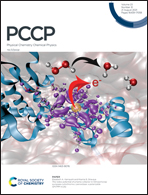Mechanism of iron complexes catalyzed in the N-formylation of amines with CO2 and H2: the superior performance of N–H ligand methylated complexes†
Abstract
CO2 hydrogenation into value-added chemicals not only offer an economically beneficial outlet but also help reduce the emission of greenhouse gases. Herein, the density functional theory (DFT) studies have been carried out on CO2 hydrogenation reaction for formamide production catalyzed by two different N–H ligand types of PNP iron catalysts. The results suggest that the whole mechanistic pathway has three parts: (i) precatalyst activation, (ii) hydrogenation of CO2 to generate formic acid (HCOOH), and (iii) amine thermal condensation to formamide with HCOOH. The lower turnover number (TON) of a bifunctional catalyst system in hydrogenating CO2 may attribute to the facile side-reaction between CO2 and bifunctional catalyst, which inhibits the generation of active species. Regarding the bifunctional catalyst system addressed in this work, we proposed a ligand participated mechanism due to the low pKa of the ligand N–H functional in the associated stage in the catalytic cycle. Remarkably, catalysts without the N–H ligand exhibit the significant transfer hydrogenation through the metal centered mechanism. Due to the excellent catalytic nature of the N–H ligand methylated catalyst, the N–H bond was not necessary for stabilizing the intermediate. Therefore, we confirmed that N–H ligand methylated catalysts allow for an efficient CO2 hydrogenation reaction compared to the bifunctional catalysts. Furthermore, the influence of Lewis acid and strong base on catalytic N-formylation were considered. Both significantly impact the catalytic performance. Moreover, the catalytic activity of PNMeP-based Mn, Fe and Ru complexes for CO2 hydrogenation to formamides was explored as well. The energetic span of Fe and Mn catalysts are much closer to the precious metal Ru, which indicates that such non-precious metal catalysts have potentially valuable applications.

- This article is part of the themed collection: 2021 PCCP HOT Articles


 Please wait while we load your content...
Please wait while we load your content...